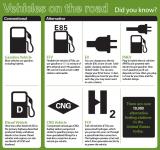Learn About Green Vehicles
What Makes a Vehicle Green?
EPA developed the Green Vehicle Guide to help you find information on vehicles that are more efficient and less polluting.
Vehicles that operate primarily on gasoline or diesel have historically accounted for over 99% of cars and passenger truck sales. However, sales of cars that operate on other fuels — particularly electricity — are growing. New models of both electric vehicles and plug-in hybrid electric vehicles are entering the market in increasing numbers each year. Other alternative fuel vehicles include those that run on compressed natural gas (CNG) or E85 (a mixture of about 85% ethanol and 15% gasoline).
Many alternative fuels "burn" cleaner than gasoline or diesel so there are fewer tailpipe emissions. The amount of greenhouse gases (GHG) emitted when the fuel is produced depends on the source of the fuel — see GHG Emissions for more information. These fuels can also be produced domestically, reducing our dependence on imported petroleum. In addition, reducing vehicle emissions and increasing your fuel economy helps the environment and your wallet.
What Are My Options?
Curious about the new vehicle technologies and fuels available today? Click on the tabs below to learn more about the different fuels that power cars.
Electricity can be produced from:
![]()
- How to Fuel
You can “refuel” at home by plugging the car into a household outlet to recharge the battery. Most EVs can be charged with a standard 120-Volt outlet. A 240-Volt outlet—like the one your dryer or electric stove uses—will charge the vehicle more quickly. Check the window sticker or fueleconomy.gov to find the charge time of the vehicle. You may also be able to plug in at work, or at one of the growing number of public charging stations.
Purchasing an EV charger? Select ENERGY STAR certified equipment to ensure the charger you are installing is energy efficient. Search EPA’s list of certified products to find a model that works for you.
- Vehicle Info
Electric vehicles (EVs) operate exclusively on electricity. Plug-in hybrid vehicles (PHEVs) operate on both electricity and gasoline.
- Did You Know?
You can estimate the GHG emissions associated with charging and driving an EV or PHEV where you live on fueleconomy.gov.
Hydrogen can be produced from:
![]()
- How to Fuel
Similar to filling your gasoline tank, you attach the nozzle from a designated hydrogen dispenser at a public station. It should take less than 10 minutes to fill up.
- Vehicle Info
Fuel cell vehicles (FCVs) powered by hydrogen are just starting to enter the vehicle market. There are currently a limited number of FCVs available.
- Did You Know?
A facility in Fountain Valley, California is producing hydrogen from wastewater.
Compressed Natural Gas can be produced from:
![]()
- How to Fuel
Similar to refilling your gasoline tank, you attach the nozzle from a designated CNG dispenser at a public station. Most public stations are fast-fill, which can fill your tank in about the same amount of time it takes to refuel a gasoline vehicle.
- Vehicle Info
CNG cars operate in a similar way to gasoline cars. The fuel — natural gas — is burned in an internal combustion engine to power the wheels.
There are currently a limited number of dedicated CNG vehicles available.
- Did You Know?
CNG generally creates fewer smog-related tailpipe emissions than gasoline, and can reduce tailpipe GHGs by about 20%. There are also GHG emissions associated with extracting, processing, and distributing CNG. Learn more about GHG emissions.
Ethanol can be produced from:
![]()
- How to Fuel
E85 (up to 85% ethanol and 15% gasoline) is a liquid fuel that is dispensed just like gasoline. It is available on specifically labeled pumps at many public stations around the country.
- Vehicle Info
Flexible Fuel Vehicles (FFVs) can operate on E85 or regular gasoline.
There are more than 17 million FFVs in the U.S. today, but many owners don't realize their car is an FFV. Check your fuel door or owner’s manual to see if you’re driving one.
- Did You Know?
There are over 2,300 gas stations that carry E85.
Biodiesel can be produced from:
![]()
- How to Fuel
Biodiesel is dispensed just like gasoline, and is available at many public stations. It can be dispensed as 100% biodiesel or as a blend with petroleum diesel. Common blends include B5 and B20, a blend of 20% biodiesel and 80% diesel.
- Vehicle Info
Most diesel vehicles can run on biodiesel, but check with your vehicle manufacturer or warranty.
- Did You Know?
Biodiesel concentrations of up to 5% (B5) are approved for safe operation in any diesel engine, including passenger cars and trucks and heavy-duty trucks.
*The sources displayed above are not intended to cover all possible feedstocks, or sources, nor do they reflect equal fractions of fuel production.
Download a vehicle fuels infographic
Text-only version of vehicle fuels infographic
GHG Emissions
Beyond Tailpipe Emissions Calculator
Many of these fuels, depending on how they are produced, reduce overall emissions of CO2 into the atmosphere relative to gasoline. In fact, operating a vehicle exclusively on electricity or hydrogen releases no harmful GHG emissions from your vehicle’s tailpipe! The amount of GHGs emitted when the fuel is produced depends on the source of the fuel. For example, generating electricity from coal creates far more emissions than electricity generated from renewable sources like wind. Learn more about emissions associated with electric vehicles.
Want to Know More?
DOE's Alternative Fuels Data Center provides information on the basics, benefits and considerations, station locators, compatible vehicles, and financial incentives for various fuels.
Visit Alternative Fuels and E85 for more information about alternative fuels and vehicles.
For basic fact sheets on E85 and biodiesel, see:
Renewable Fuel Standard (RFS)
EPA is responsible for developing and implementing regulations to ensure that transportation fuel sold in the U.S. contains a minimum volume of renewable fuel. Visit EPA's Renewable Fuels Standard site for more information.

